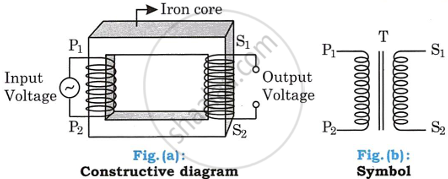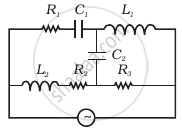Advertisements
Advertisements
प्रश्न
Explain the construction and working of the transformer.
उत्तर
Construction: It consists of two coils of primary and secondary coils insulated from each other and wound on a soft iron core as shown in fig. (a). Input is applied across the primary coil, and output is taken across the secondary coil.

Notations:
P1, P2: Primary coil
S1, S2: Secondary coil
There are two types of transformers:
- Step-up transformer: In this, the number of turns in the primary coil is less than the number of turns in the secondary coil. The primary coil is made up of thick wire, and the secondary coil is made up of thin wire.
- Step-down transformer: Here the number of turns in the primary coil is greater than that in the secondary coil. The secondary coil is made up of thick wire, and the primary coil is of thin wire.
Working: When an AC voltage is applied to the primary coil, the current through the coil goes on changing. Hence the magnetic flux through the core also changes. As this changing magnetic flux is linked with both coils, an emf is induced in each coil. The amount of magnetic flux linked with the coil depends upon the number of turns of the coil.
APPEARS IN
संबंधित प्रश्न
Derive an expression for ratio of e.m.f.s and currents in terms of number of turns in primary and secondary coil.
A group of students while coming from the school noticed a box marked "Danger H.T. 2200 V" at a substation in the main street. They did not understand the utility of a such a high voltage, while they argued, the supply was only 220 V. They asked their teacher this question the next day. The teacher thought it to be an important question and therefore explained to the whole class.
Answer the following questions:
(i) What device is used to bring the high voltage down to low voltage of a.c. current and what is the principle of its working ?
(ii) Is it possible to use this device for bringing down the high dc voltage to the low voltage? Explain
(iii) Write the values displayed by the students and the teacher.
Derive an expression for e.m.f. and current in terms of turns ratio
How much current is drawn by the primary of a transformer connected to 220 V supply when it delivers power to a 110 V − 550 W refrigerator?
Mention various energy losses in transformer device
How is the e.m.f. across primary and secondary coils of a transformer related with the number of turns of the coil in them?
You are required to make an electromagnet from a soft iron bar by using a cell, an insulated coil of copper wire and a switch. (a) Draw a circuit diagram to represent the process. (b) label the poles of the electromagnet.
Explain the significance of Lenz’s law to show the conservation of energy in electromagnetic induction.
For what purpose are the transformers used? Can they be used with a direct current source?
How are the e.m.f in the primary and secondary coils of a transformer related with the number of turns in these coils?
Why is the iron core of a transformer made laminated (thin sheets) instead of being in one solid piece?
The transformer is used in ______ current circuits.
What is the function of a transformer in an a.c. circuit? How do the input and output powers in a transformer compare?
Name two kind of energy loss in a transformer. How is it minimized?
State the principle of working of a transformer. Can a transformer be used to step up or step down a d.c. voltage? Justify your answer.
What is the turns ratio i.e., transformer ratio, ns: np, in an ideal transformer which in-creases ac voltage from 220 V to 33000 V?
In an ideal transformer, an output of 66 kV is required when an input voltage of 220 V is available. If the primary has 300 turns, how many turns should the secondary have?
Can a transformer be used with direct current source? Give reason.
State the factors on which the frequency of the alternating e.m.f. depends.
Name the principle on which functioning of a transformer depends.
Name three losses of energy in a transformer. How are they minimized?
(i) Draw a clear labelled diagram of an electric bell.
(ii) Explain in brief, its working.
(iii) What material is used for the core of an electric bell? State the reason.
The primary coil of a transformer has 200 turns while the secondary coil has 1000 turns. What type of transformer is this? if the input voltage is 10V, what will be the output voltage?
Applying e.m. f to primary coil is 210 V. If the number of turns in primary coil is 200 turns and that of in secondary coil is 20 turns, then find out the output voltage. Name the type of transformer.
Devices which is used to convert high alternating current to low alternating current is ______.
In a series resonant RLC circuit, the voltage across 100 Ω resistor is 40 V. The resonant frequency ω is 250 rad/s. If the value of C is 4 µF, then the voltage across L is
What are step-up and step-down transformers?
Mention the various energy losses in a transformer.
Find out the phase relationship between voltage and current in a pure inductive circuit.
The output power in step-up transformer used in practice is ______.
Assertion: A transfonner cannot work on D.C. supply.
Reason: D.C. changes neither in magnitude nor in direction.
A transformer works on the principle of ______.
For an ideal step-down transformer, the quantity which is constant for both the coils is ______.
Which among the following, is not a cause for power loss in a transformer?
Read the following paragraph and answer the question:

Long distance power transmissions
The large-scale transmission and distribution of electrical energy over long distances is done with the use of transformers. The voltage output of the generator is stepped up. It is then transmitted over long distances to an area sub-station near the consumers. There the voltage is stepped down. It is further stepped down at distributing sub-stations and utility poles before a power supply of 240 V reaches our homes.
We need to step-up the voltage for power transmission, so that ______.
A transformer is essentially an a.c. device. It cannot work on d.c. It changes alternating voltages or currents. It does not affect the frequency of a.c. It is based on the phenomenon of mutual induction. A transformer essentially consists of two coils of insulated copper wire having different numbers of turns and wound on the same soft iron core.
The number of turns in the primary and secondary coils of an ideal transformer is 2000 and 50 respectively. The primary coil is connected to a main supply of 120 V and secondary coil is connected to a bulb of resistance 0.6 Ω.
The value of voltage across the secondary coil is ______.
A transformer is essentially an a.c. device. It cannot work on d.c. It changes alternating voltages or currents. It does not affect the frequency of a.c. It is based on the phenomenon of mutual induction. A transformer essentially consists of two coils of insulated copper wire having different numbers of turns and wound on the same soft iron core.
The number of turns in the primary and secondary coils of an ideal transformer is 2000 and 50 respectively. The primary coil is connected to a main supply of 120 V and secondary coil is connected to a bulb of resistance 0.6 Ω.
The value of current in the bulb is ______.
A transformer is essentially an a.c. device. It cannot work on d.c. It changes alternating voltages or currents. It does not affect the frequency of a.c. It is based on the phenomenon of mutual induction. A transformer essentially consists of two coils of insulated copper wire having different numbers of turns and wound on the same soft iron core.
The number of turns in the primary and secondary coils of an ideal transformer is 2000 and 50 respectively. The primary coil is connected to a main supply of 120 V and secondary coil is connected to a bulb of resistance 0.6 Ω.
Power in primary coil is ______.
The primary coil of a transformer has 800 turns and the secondary coil has 8 turns. It is connected to a 220 V ac supply. What will be the output voltage?
The primary winding of a transformer has 100 turns and its secondary winding has 200 turns. The primary is connected to an a.c supply of 120 V and the current flowing in its is 10 A. The voltage and the current in the secondary are ______.
The line that draws power supply to your house from street has ______.
- zero average current.
- 220 V average voltage.
- voltage and current out of phase by 90°.
- voltage and current possibly differing in phase `phi` such that `|phi| < pi/2`.
Draw the effective equivalent circuit of the circuit shown in figure, at very high frequencies and find the effective impedance.

A 60 W load is connected to the secondary of a transformer whose primary draws line voltage. If a current of 0.54 A flows in the load, what is the current in the primary coil? Comment on the type of transformer being used.
1 MW power is to be delivered from a power station to a town 10 km away. One uses a pair of Cu wires of radius 0.5 cm for this purpose. Calculate the fraction of ohmic losses to power transmitted if
- power is transmitted at 220 V. Comment on the feasibility of doing this.
- a step-up transformer is used to boost the voltage to 11000 V, power transmitted, then a step-down transfomer is used to bring voltage to 220 V. (ρCu = 1.7 × 10–8 SI unit)
A transformer operating at primary voltage 8 kV and secondary voltage 160 V serves a load of 80 kW. Assuming the transformer to be ideal with purely resistive load and working on unity power factor, the loads in the primary and secondary circuit would be:
In a transformer, number of turns in the primary coil are 140 and that in the secondary coil are 280. If current in primary coil is 4 A, then that in the secondary coil is ______.
An ideal transformer converts 220 V a.c. to 3.3 kV a.c. to transmit a power of 4.4 kW. If primary coil has 600 turns, then alternating current in secondary coil is ______.
Two coils P and Q are kept near each other. When no current flows through coil P and current increase in coil Q at the rate 10A/s, the emf in coil P is 15mV. When coil Q carries no current and current of 1. 8A flows through coil P, the magnetic flux linked with the coil Q is ______.
Efficiency of transformer is the ratio of ______.
The primary coil of a transformer has 60 turns whereas its secondary coil has 3000 turns.
If a current of 5A flows in the primary coil, how much current will flow in a load in the secondary coil? State the assumption you have made regarding the transformer, in this calculation.
